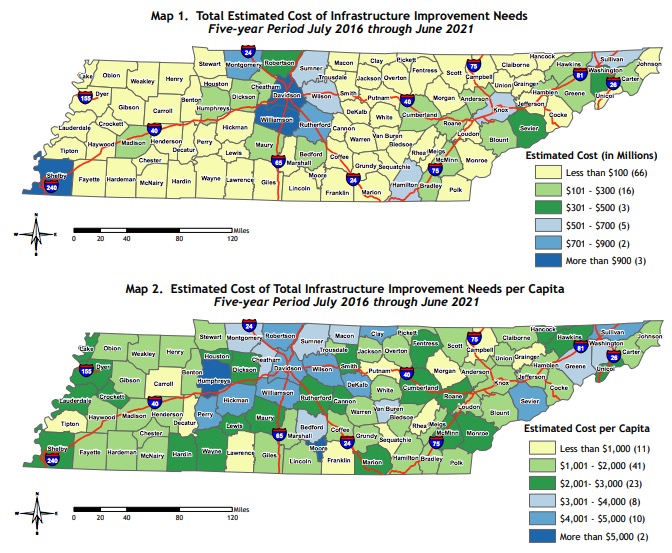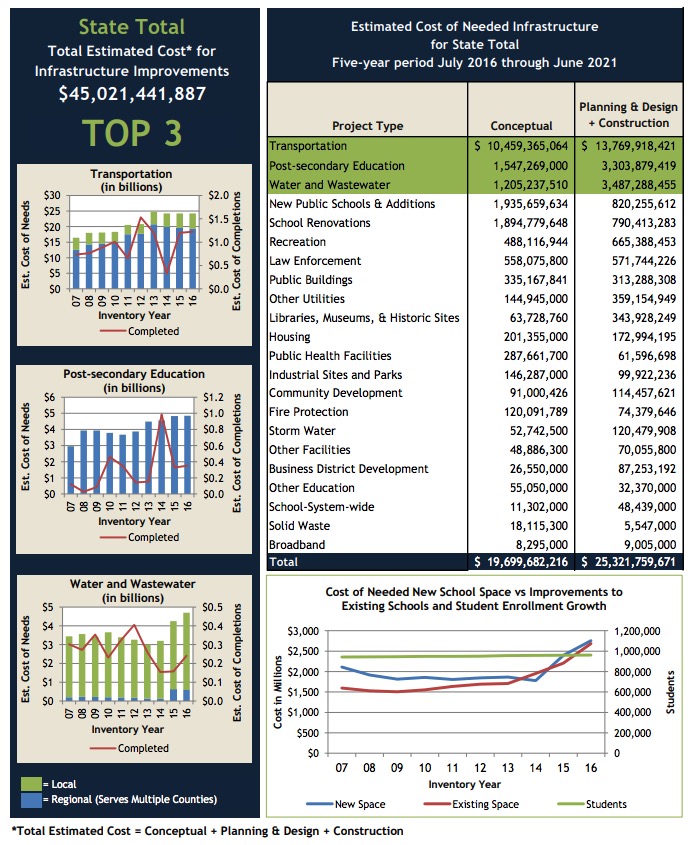TENNESSEE ADVISORY COMMISSION ON INTERGOVERNMENTAL RELATIONS (TACIR)
Introduction
 One of the greatest fiscal challenges facing our elected officials is dealing with aging infrastructure. As the population grows and shifts, new classrooms must be built and equipped to meet our children’s needs. As roads and bridges wear out, they must be repaired or replaced to ensure our safety. And as outdated water lines begin to crack and fail, they must be upgraded to carry clean drinking water safely and efficiently. These examples are just a few of the demands confronting government officials as they struggle with the daunting task of matching limited funds to seemingly unlimited needs.
One of the greatest fiscal challenges facing our elected officials is dealing with aging infrastructure. As the population grows and shifts, new classrooms must be built and equipped to meet our children’s needs. As roads and bridges wear out, they must be repaired or replaced to ensure our safety. And as outdated water lines begin to crack and fail, they must be upgraded to carry clean drinking water safely and efficiently. These examples are just a few of the demands confronting government officials as they struggle with the daunting task of matching limited funds to seemingly unlimited needs.
Why do we rely on the public sector for roads, bridges, water lines, and schoolhouses? Certain goods and services—such as clean drinking water and roads to access employment, education, and commerce—must be provided in the interest of general health and safety. Excluding users from clean water and roads is not desirable, and profit may not always be possible. Public infrastructure is the answer when the service supported is essential to the common good and the private sector cannot profitably provide it at a price that makes it accessible to all. Therefore, we look to those who represent us in our public institutions to set priorities and find ways to fund them.
Why inventory public infrastructure needs?
The Tennessee General Assembly affirmed the value of public infrastructure in legislation enacted in 1996 when it deemed an inventory of those needs necessary “in order for the state, municipal, and county governments of Tennessee to develop goals, strategies, and programs which would
- improve the quality of life of its citizens,
- support livable communities, and
- enhance and encourage the overall economic development of the state
through the provision of adequate and essential public infrastructure.” The public infrastructure needs inventory on which this report is based was derived from surveys of local officials by staff of the state’s nine development districts,2 the capital budget requests submitted to the Governor by state officials as part of the annual budget process, needed capital projects provided by the Tennessee Board of Regents (TBR), and bridge and road needs from project listings provided by state transportation officials. The Commission relies entirely on state and local officials to evaluate the infrastructure needs of Tennessee’s citizens as envisioned by the enabling legislation.
What infrastructure is included in the inventory?
Local officials were asked to describe anticipated needs for the period July 1, 2016, through June 30, 2036, classifying those needs by type of project. State-level needs were derived from capital budget requests. Both state and local officials were also asked to identify the stage of development— conceptual, planning and design, or under construction—as of July 1, 2016. The period covered by each inventory was expanded to 20 years in 2000 because of legislation requiring its use by the Commission to monitor implementation of Tennessee’s Growth Policy Act.4 Plans developed pursuant to that act established growth boundaries for annexation by the state’s municipalities. This report focuses on the first five years of the period covered by the inventory and the following types of public infrastructure (see the glossary for definitions of project types):
Transportation and Utilities
- Transportation
- Broadband
- Other Utilities
Education
- Post-secondary Education
- School Renovations
- New Public Schools and Additions
- School System-wide
- Other Education
Health, Safety, and Welfare
- Water and Wastewater
- Law Enforcement
- Public Health
- Storm Water
- Fire Protection
- Solid Waste
- Housing
Recreation and Culture
- Recreation
- Libraries, Museums, and Historic Sites
- Community Development
General Government
- Public Buildings
- Other Facilities
Economic Development
- Industrial Sites and Parks
- Business District Development
Within these parameters, local officials are asked to report their needs as they relate to developing goals, strategies, and programs to improve their communities. They are limited by only the very broad purposes for public infrastructure as prescribed by law. No independent assessment of need constrains their reporting. In addition, the inventory includes bridge and road needs from project listings provided by the Tennessee Department of Transportation (TDOT), capital projects from TBR, and capital needs identified by state officials and submitted to the governor as part of the annual budget process.
How is the inventory accomplished?
The public infrastructure needs inventory is developed using two separate, but related, inventory forms to gather information from local officials about needed infrastructure improvements. The Existing School Facility Needs Inventory Form is used to gather information about the condition of existing public school buildings, as well as the cost to meet all facilities mandates at the schools, put them in good condition, and provide adequate technology infrastructure. The General Public Infrastructure Needs Inventory Form is used to gather information about all other types of infrastructure including the need for new public school buildings and for school system-wide infrastructure improvements not gathered on the school inventory form. TACIR staff provide local officials with supplemental information from the state highway department about transportation needs, many of which originate with local officials. This information helps ensure that all known needs are captured in the inventory.
In addition to gathering information from local officials, TACIR staff incorporate capital improvement requests submitted by state officials to the Governor’s Budget Office, bridge and road needs from project listings provided by TDOT, and needed capital projects from TBR. While TACIR staff spend considerable time reviewing all the information in the inventory to ensure accuracy and consistency, the information reported in the inventory is based on the judgment of state and local officials. In many cases, information about local needs is limited to those included in the capital improvements programs of local governments, which means the inventory may not fully capture all local needs.
As discussed above, projects included in the report are only those in the conceptual, planning and design, or construction stage at some point during the five-year period July 2016 through June 2021. Estimated costs for the projects may include amounts spent before July 2016 for projects started before the five-year period or amounts after June 2021 for projects that won’t be completed during the five-year period. Because the source of information from state agencies (other than TDOT and TBR) is their capital budget requests, all of those projects are initially recorded as conceptual.
In the context of the public infrastructure needs inventory, the term “mandate” is defined as any rule, regulation, or law originating from the federal or state government that affects the cost of a project. The mandates most commonly reported are the Americans with Disabilities Act (ADA), asbestos, lead, underground storage tanks, and the Education Improvement Act (EIA). The EIA mandate was to reduce the number of students in each K-12 public school classroom by fall 2001. Tennessee public schools began working toward that goal after the passage of the EIA in 1992 and met it by hiring a sufficient number of teachers and adding classroom space. 7 However, some schools continue to use portable classrooms because they still do not have sufficient traditional classroom space to accommodate the classes and teachers required.
Except in the case of existing public schools, the inventory does not include estimates of the cost to comply with mandates. Even in the case of public schools, with the exception of the EIA, the cost reported to the Commission as part of the public infrastructure needs inventory is relatively small— accounting for less than 1% of the total reported public school infrastructure needs. See Appendix E-9.
Download full version (PDF): Building Tennessee’s Tomorrow
About the Tennessee Advisory Commission on Intergovernmental Relations (TACIR)
www.tn.gov/tacir
The Tennessee Advisory Commission on Intergovernmental Relations (TACIR) was created in July 1978 by Chapter 939 of the Public Acts of 1978. TACIR was created in response to legislative findings in the late 1970s indicating the need for a permanent intergovernmental body to study and take action on questions of organizational patterns, powers, functions, and relationships among federal, state, and local governments.
Tags: TACIR, Tennessee, Tennessee Advisory Commission on Intergovernmental Relations, TN







 RSS Feed
RSS Feed